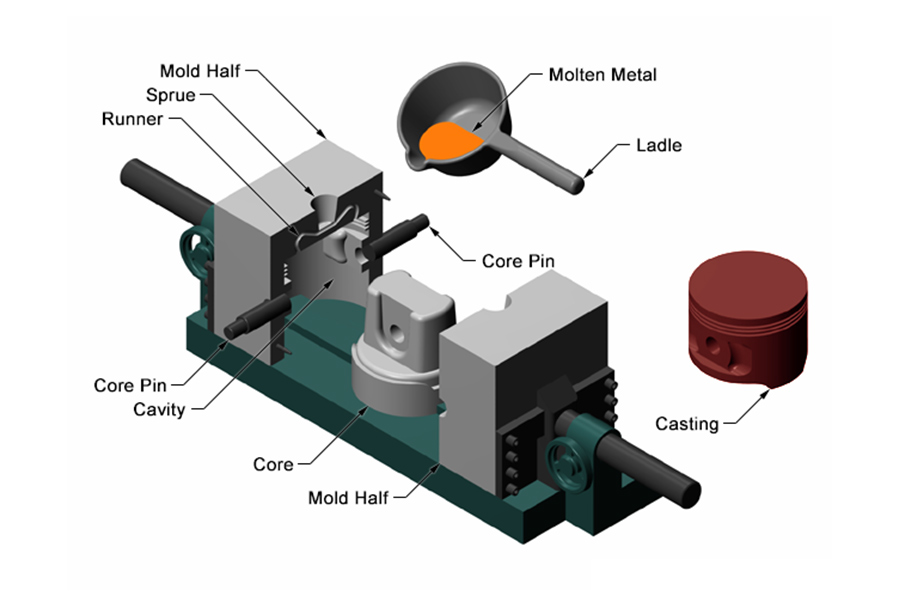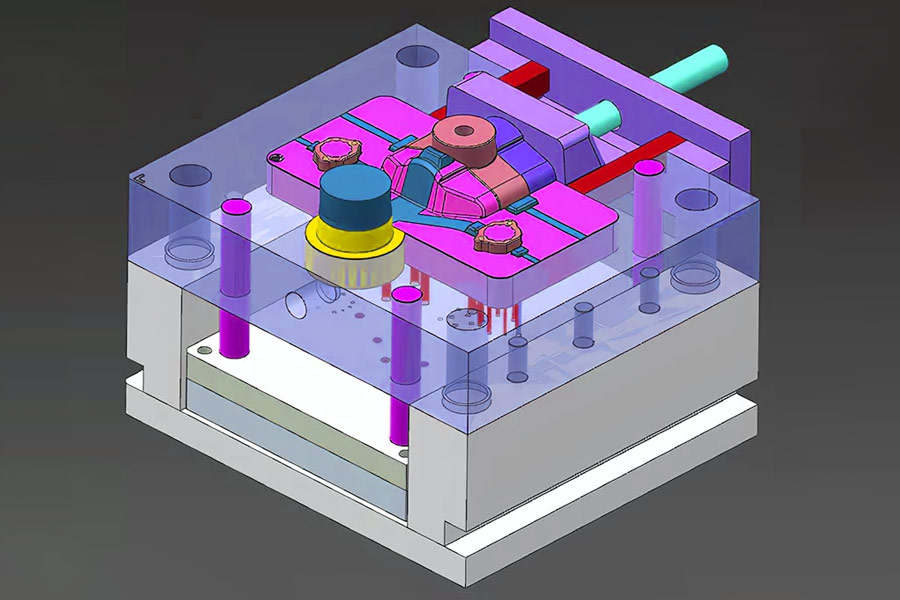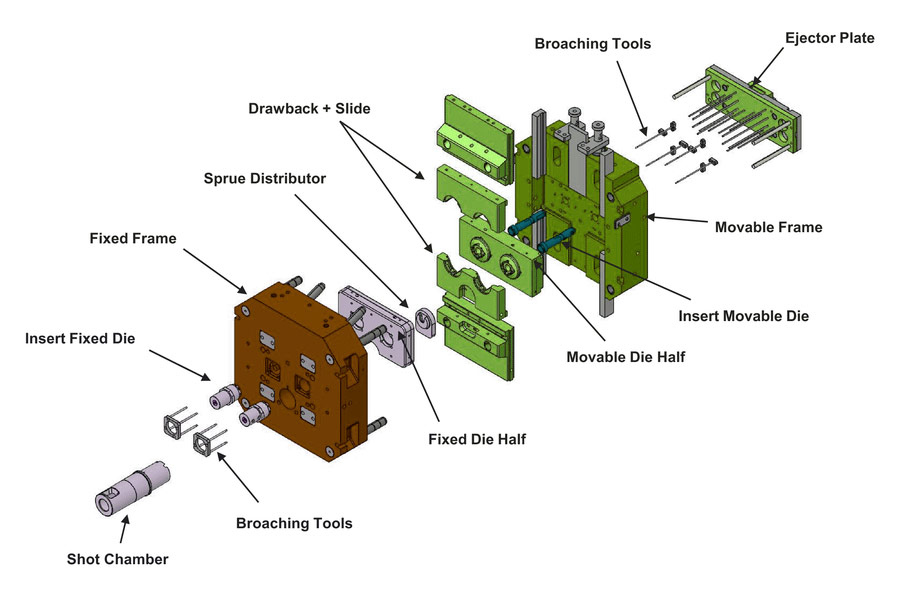Die casting is a popular manufacturing process for mass production of a variety of metal parts such as gears, door handles, engine blocks, steering wheels, and electrical parts. An important aspect of the process is the die casting molds. It is an important determinant of the appearance of the final product, given its ability to repeatedly manufacture complex components with high accuracy.While the die casting process is the best option for producing complex parts, operation and operation are quite challenging from die casting design to understanding its components and steps. This knowledge is required to select the best mold according to your manufacturing requirements.
In this article, you will learn how these molds are common structures, manufacturing processes, common structures, and how they are designed. You will also understand the material types and components of the die-casting forms. Finally, you will learn how to repair the die and the factors to make the perfect die tool.
What is die casting mold?
Die casting mold determines the shape of the die casting and affects its performance. It is an assembly tool used to manufacture the die-casting piece. In any case, it is mainly composed of type cavity, type core and roof out system. Mold design is one of the essential steps in the production process because the shape and properties of the mold affect the final part. The die casting process begins by pressing the molten alloy into the die with the help of high pressure and requires molds of the same size to complete the desired product.

Advantages of die casting mold
- Achievable Net shape part configuration
- Achievable high dimensional accuracy
- Fast production
- Achievable Thinner walls when compared to the sand castings
- Wide range of possible die casting product/parts shapes including complex
- The die casting mold can achieve the right heat balance
- Can solidify uniformly and quickly
- Help the pressure transfer
- Maintain good fluidity to fill the excellent formability of the mold
- Improve the surface quality of the finalized part
Common construction of die casting mold
| Construction | Concrete Analysis |
| Fixed mold and moving mold | Die setting: fixed on the die mounting plate of the die casting machine, connected with the chamber of the die casting machine, and the pouring system is connected with the chamber.Moving die: install on the moving mode mounting plate of the die casting machine, and use the fixed mold close mold or open mold along with the movement of the moving mold mounting plate. |
| Forming part | Type chamber: the part forming the outer surface of the die cast, formed from the combination of the corresponding part of the die and the moving die.Type core: the part forming the inner surface of the die cast, usually installed in the moving die or die. |
| The pouring system | The part of the mold cavity and the pressing chamber of the press casting machine, that is, the channel of the metal liquid entering the cavity, is composed of direct pouring channel, transverse pouring channel and inner pouring gate. |
| Discharge system | The channel that eliminates the gas in the pressure chamber, pouring channel and type chamber generally includes the exhaust tank and overflow tank. |
| Ejecting mechanism | The mechanism that pushes the die cast out from the die, including the push plate, the push bar fixing plate, the push rod, the push plate guide sleeve and the push plate guide column. |
| Side core pumping mechanism | Pull the mechanism of the forming parts which is inconsistent with the opening and closing die direction, and complete the core drawing action before the die casting is rolled out. |
| Guide parts | The guide fixed modes and moving parts, such as the guide column and the guide sleeve, move reliably in certain directions between the open and close modes. |
| Supporting part | Including upper base, lower base, base, etc. for supporting and fixing each part of the mold, and install the mold to the die casting machine. |
| Other | In addition to the aforementioned structure, there are other fasteners and positioning parts in the mold, such as screws, pins, limit nails, etc. |
Type of die casting mold
1.Cold chamber die casting mold
Cold chamber die casting mold, also known as gravity die casting mold, is especially suitable for aluminum, copper, zinc and other alloys. It is a new type of mold developed on the basis of low-pressure casting process, mainly composed of pouring system, cooling system and release system. It operates by injecting the metal liquid into the die cast cavity through the feed channel. When the mold cavity is filled, the pressure is locked, thus realizing the forming of the metal. It is quite different from the traditional hot chamber die casting mold. Cold chamber die casting mold is famous for its simple structure, lasting service life and wide applications.
2.Thermal chamber die casting mold
Hot chamber die casting mold is also known as ejection die casting mold, mainly used in die casting lead, zinc, magnesium and other alloys. Thermal chamber pressure casting is a fast solidification technology, which can realize the continuous flow and stable filling of metal liquid material in the mold cavity, so as to improve the production efficiency and reduce the production cost. The device is operated by using a furnace to heat the metal material to ensure that it is at high temperature, and then by sending it into a die casting chamber for pressing. The mold can be removed after cooling the material to room temperature. Hot chamber die casting mold is famous for its fast forming speed, high efficiency and excellent detail precision.
3.Alloy casting mold
Alloy casting die is designed for many alloy materials such as die casting iron and die casting steel. Die casting is widely used in industry because of its dense and uniform tissue, no pores and inclusions, no cracks, and bright and beautiful surface. Compared with the traditional die casting molds, the cavity material of alloy casting molds is more unique, usually made from refractory material or superalloy material. Alloy casting die is mainly used in the molding processing of thin wall casting in die casting production, and can also be used in the precision forming and mass production of large complex cavity parts. Die features for alloy casting include durability at high temperatures, high hardness and precise size.
4.Low pressure casting mold
For aluminum, magnesium and other non-iron casting alloy, low pressure casting mold is applicable. The main advantages of low-pressure casting technology are high production efficiency, low cost and stable and reliable quality, which have broad application prospects in the automobile industry. It operates by using low-pressure compression technology to push molten metal into the mold to create castings. Low pressure casting die is characterized by its high precision fabrication and good surface finish.
5.Gravity casting mold
Gravity casting method is mainly suitable for aluminum alloy and copper alloy casting process. Its operation mechanism depends on the influence of geentric gravity, prompting the metal fluid to flow from top to bottom to the mold, thus forming the casting part. Gravity casting mold has the characteristics of stable component size and low energy consumption.
6.Plasma spray mold
Plasma spraying mold technology is very suitable for die casting of very fine particles such as iron oxide and ceramics. The working mechanism of this equipment is to apply a plasma ceramic coating to the appearance of the mold, so that the appearance of the whole mold is more smooth, more wear-resistant and more corrosion resistant, further extending the service life of the mold and improving the quality of the finished product.

Material of die casting mold
Material selection of die casting die is essential for the performance and life of the die. The following are the commonly used materials and their characteristics of die-casting molds:
Aluminium alloy
- Aluminum alloy is a lightweight, high strength material with good thermal conductivity and corrosion resistance.
- In the die casting mold, aluminum alloy is mainly used in the manufacture of mold shell, mold base and other parts.
Copper alloy
- Copper alloy has good thermal conductivity and wear resistance, and can withstand high temperature and high pressure working environment.
- In die casting mold, copper alloy is mainly used to manufacture parts such as shunt cone and nozzle of mold.
Steels
- Steel is one of the most commonly used materials in die casting mold, it has good strength, toughness and wear resistance, can withstand high temperature and high pressure working environment.
- Commonly used steel has 45 # steel, 50 # steel, Cr12MoV mold steel, etc. Among them, H13 (4Cr5MoSiVl) steel is widely used in die casting mold because of its good toughness, thermal fatigue resistance and oxidation resistance.H13 steel is a kind of hot-working die steel, mainly composed of chromium alloy elements, after the appropriate surface treatment, its service life can reach a very high level.

Iron casting
- Cast iron is another commonly used die-casting mold material, with good mechanical properties, corrosion resistance and thermal conductivity characteristics.
- The commonly used cast iron has grey cast iron, ductile cast iron and alloy cast iron.
High speed steel
- High speed steel has good wear resistance and heat resistance, and is suitable for manufacturing die-casting molds with high wear resistance requirements.
- High speed steel also has good cutting performance, good processing performance, can be used to manufacture more complex shapes of the mold.
Stainless steel
- Stainless steel is a material with excellent corrosion resistance, suitable for the manufacture of workpieces with high mold requirements.
- Stainless steel has high hardness and strength and good wear resistance, which is suitable for long-term die casting mold.
Engineering plastics
- Engineering plastics is a kind of material with good wear resistance, impact resistance, corrosion resistance and high temperature resistance.
- Commonly used engineering plastics include nylon, polystyrene, etc.which are suitable for manufacturing workpieces with high surface requirements and light weight requirements of the mold.
Principles of the selection of die casting mold materials
- Can meet the requirements of the working conditions of the die-casting material.
- The die size is determined according to the size of the die casting.
- Large and medium-sized precision die casting molds should be selected with good processing performance, reliable performance and long die life.

Working conditions of the die casting mold
- The working conditions of the die casting molds are very bad compared to other molds, because the die casting metal is different, so it bears the high pressure of 150-500MPa.
- The work is often in contact with 300℃ ~1000℃ of molten metal, and the casting temperature of different die casting alloys is also different. And repeated heating and cooling, with a large temperature gradient along the section.
- Severe wear will occur when the molten metal enters the cavity at a higher velocity of 150 m/s to 70 m/s.
- Under the influence of liquid metal erosion, the metal can easily adhere to the mold cavity surface, and even penetrate to the mold surface to corrode the mold.
Manufacturing process of the die casting mold
The manufacturing process of the die casting mold is a complex process involving multiple links. The following is a clear summary and detailed explanation of the die-casting mold manufacturing process:
Mold design
This is the first step and a very critical step in the die casting mold process. The design process considers the shape and size of the final product, as well as the structural characteristics, material flow, and cooling mode to ensure the quality and accuracy of the final product. Reasonable designed mold can reduce problems in the actual production and improve the qualified rate of casting.
Material preparation
Commonly used metal materials include aluminum alloy, zinc alloy, magnesium alloy, etc. Strict quality control is required to ensure that the composition and properties of the material meet the requirements.
Mold manufacturing
Mold manufacturing is the key link in die casting die process. Need to process the various parts of the mold according to the mold design drawings, and then the assembly and debugging. The quality of mold manufacturing directly affects the quality and precision of the final product, so each processing link needs to be strictly controlled.
Casting
After the mold is made, the casting process is performed. Casting means that the metal material is heated to a melted state and then injected into the mold for molding. During the casting process, the temperature and flow speed of the metal need to be controlled to ensure the molding quality of the product.
Cooling
After the metal is injected into the mold, a cooling process is required. The cooling process needs to determine the cooling time and method according to the characteristics of the metal material and the requirements of the product. The control of the cooling process directly affects the organization structure and performance of the product.
Mold unloading
When the product is cooled and solidified, perform the release operation. Molding removes the molded product from the mold. During the release process, it is necessary to avoid the deformation or damage of the product, and it is also necessary to clean and maintain the mold.
Reprocessing
Finally, the molded product was post-processed. Post-treatment includes the removal of the oxide layer on the product surface, the trimming of the size and shape of the product, and the surface treatment, etc. Through post-treatment, the appearance quality and corrosion resistance of the products can be improved.

Design of die casting mold
Step 1: Design and specification
The process of die casting mold begins with careful planning and mold design. Engineers and designers collaborate to conceive the product and translate its specifications into a detailed design.This involves understanding the geometry, tolerances, and complexity of the final components. CAD software plays a key role at this stage to create 3D models and complex designs that meet industry standards and end-product specific requirements.
In addition, it is important to understand which type of die casting machine (hot chamber or cold chamber die casting machine) will be used during the manufacturing phase.
Step 2: Die and die base preparation
When the design is complete, the focus will shift to die casting forms and holder preparation. Skilled mold makers use advanced steel or other materials that can withstand high temperature and high pressure to elaborate mold components, including mold chambers and mold cores.
Precision machining techniques such as CNC milling and EDM (EDM) ensure the accuracy of forming these components and maintain the integrity of the intended design.
Step 3: mold assembly and finishing
After making each part, the assembly of the die casting mold becomes the top priority. This complex process involves meticulous assembly, alignment, and fixation of individual components.
Every detail is important from ensuring proper ventilation and cooling channels to integrating overhead pins and sliders to easily top the final components. Finishing and surface treatment are used to improve the durability of the die, prevent corrosion and promote smooth operation in the casting process.
Step 4: Test and verification
Strict testing and verification must be performed before the mold is put into full production. Conduct commissioning to assess the functionality, integrity of the mold and the quality of the castings. Adjustment and adjustments may be required to optimize mold performance, ensure it meets the required specifications and consistently produce high quality parts.
Step 5: Production and maintenance
Once the mold passes the validation phase, it can be deployed in the production environment. The die casting process began, injecting molten metal into the mold chamber at high pressure, forming the shape of the mold and forming the desired components.
Regular maintenance and maintenance of molds is essential to extend the service life of molds and ensure the quality of manufacturing parts. This includes cleaning, lubrication, and periodic inspections to identify and address any wear or potential problems during the mass production process.

The importance of die casting mold design
The die casting die design determines the shape, quality, configuration and uniformity of the final parts manufactured by the die casting process. Inappropriate or incomplete specifications may lead to part corrosion and poor quality of the output parts, while valuable designs can improve efficiency and production speed. When it comes to the exact specifications of the project, many die casting die design factors need to be considered, such as die drawing, corners, type line, bumps, ribs, holes and windows, symbols and wall thickness.
Maintenance of the die casting mold
Maintenance of die die is the key to ensure long-term stable operation of die and improve product quality and production efficiency. The following die casting mold maintenance method:
- Regular cleaning: clean the surface and interior of the mold regularly to remove residual metal debris, oil stains and other impurities to prevent corrosion and damage to the mold surface.
- Lubrication maintenance: Lubricate and maintain the moving parts and friction parts of the mold to ensure that the mold can run smoothly when working and reduce wear and friction.
- Regular inspection: regularly check all parts of the mold, including the surface of the mold, cooling system, shooting system, etc., and repair the problems in time to avoid the expansion of problems and affect the service life of the mold.
- Control the use temperature: strictly control the use temperature of the mold to avoid damage to the mold if too high or too low the temperature.
- Reasonable use: when using the mold, to follow the correct use method, to avoid excessive impact or excessive use, so as not to damage the mold.
- Storage: When the mold is not used, it should be properly stored and kept to avoid moisture, damage or other adverse effects.

Longsheng: Your reliable die casting die manufacturer
In Longsheng, we are not only proficient in various mold processing skills, but also we have a professional technical team that can provide leading die-casting die manufacturing services to make high quality parts for you at a very competitive price. As a company with ISO 9001:2015 certification, we focus on the construction of quality management system to provide reliable service for our customers.Our team of experts has experience performing DfM (Manufacturability Design) analysis to improve your design. We are not only a manufacturer, but also a partner dedicated to providing full support and professional advice to ensure that the design can reduce manufacturing costs while still meeting high quality standards.

If you have a design model to manufacture, please upload it to us immediately and we will offer you a quote immediately. Choosing Longsheng is to choose high quality, high technical level and high cost performance of die casting mold manufacturing partners, let us work together to create excellent parts for your project and achieve greater success.
Conclusion
The die casting mold is a combination of precision engineering, technology and meticulous detail. Each step from the initial design stage to the production workshop requires expertise and precision to ensure that the mold functions and produces consistent, high-quality parts. With the continuous progress of technology, the innovation of materials, processing technology and design methods will further improve the production process of die casting mold, and continue to break the boundary of manufacturing excellence.
FAQs
How is the die casting mold made?
Die casting die through a fine production process, including precision machining and tool machining. This method uses high quality materials and advanced manufacturing techniques to ensure the manufacture of molds that meet precise specifications.
How much is the average price of a die-casting mold?
The price of the die casting mold will be affected by a variety of factors, including the mold size, complexity, material selection, manufacturing process, etc. Generally, the price of die-casting molds can range from thousands to hundreds of thousands of dollars.Small and simple die-casting molds are relatively cheap, while large and complex molds can be very expensive. In addition, high-quality mold materials and precision machining will also increase the cost of the mold.If you need a specific quotation, it is recommended that you directly upload the design model that you need to manufacture, and they can give an accurate quotation according to your specific requirements and design requirements.
How to save the cost of die casting mold?
Through optimization design, adoption of new materials, energy management and equipment use, raw material control, automation technology, equipment maintenance and preheating, real-time monitoring and infrared detection system, can effectively save the cost of die casting mold.
How does the material affect the mold performance?
The choice of material has a significant effect on the performance of the die casting molds. Choosing the best material is essential to ensure durability, efficient thermal conductivity, and overall service life, directly affecting the quality and consistency of the final casting.
Resource
Mold Filling and Prevention of Gas Entrapment in High-pressure Die-casting
Technological parameters of die casting and quality of casting from EN AC46500 alloy


